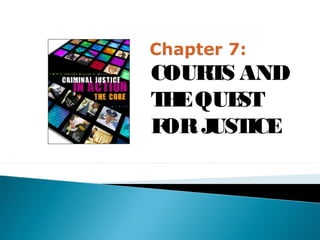
Chapter7
- 1. COURT AND S T E QUE H ST FOR J ICE UST
- 2. Due Process and Crime Control in the Courts ◦ The Due Process Function ◦ The Crime Control Function The Rehabilitation Function The Bureaucratic Function
- 3. Define jurisdiction, and contrast geographic and subject matter jurisdiction.
- 4. Jurisdiction - the authority of a court to hear and decide cases within an area of the law or a geographic territory. ◦ Geographic jurisdiction ◦ International jurisdiction ◦ Subject-matter jurisdiction Courts of general jurisdiction Courts of limited jurisdiction
- 5. Explain the difference between trial and appellate courts.
- 6. Trial Courts: Have original jurisdiction Are concerned with questions of fact Appellate Courts: Courts of review Concerned with questions of law
- 7. The dual court system is comprised of both federal and state courts. Both federal and state courts have limited jurisdiction ◦ Federal courts enforce federal statutes. ◦ State courts enforce state statutes. The distinction between the courts is not always clear. In some cases, both courts have jurisdiction over the same criminal behavior.
- 9. Outline the several levels of a typical state court system.
- 11. The state court system includes: Courts of limited jurisdiction Trial courts of general jurisdiction Appellate courts The state’s highest courts
- 12. Outline the federal court system.
- 13. Three-tiered model: U.S. District Court U.S. Court of Appeals United States Supreme Court
- 15. The United States Supreme Court: Highest court in the United States Nine justices, led by the Chief Justice Reviews fewer than 0.5 percent of cases Cases selected through writ of certiorari, issued by the rule of four Makes policy in two ways: ◦ Judicial review ◦ Interpretation of the law
- 16. Explain briefly how a case is brought to the Supreme Court.
- 17. The United States Supreme Court normally does not hear any evidence. The court’s decision is based on the written records, written arguments, and occasionally oral arguments. Justices decide each case in conference, and then the senior justice on the majority side writes the opinion. ◦ Concurring opinions ◦ Dissenting opinions
- 18. The duties of judges before trial include determining: Whether there is sufficient probable cause to issue an arrest or search warrant, or to authorize electronic surveillance Whether the defendant should be release on bail and the amount of that bail Whether to accept pretrial motions Whether to accept a plea bargaining
- 20. Questions: ◦ We don’t typically think of being a judge as a “high-risk” job like we do a police officer. Do you think if you were a family court judge you were consider potential familial reactions into your verdicts? Do you think the risk represented in this story is real, or another example of media over-exaggeration?
- 21. Selection of federal court judges ◦ Appointed by the President and confirmed by the senate Selection of state court judges ◦ Appointment ◦ Election Partisan elections Nonpartisan elections ◦ Merit selection (The Missouri Plan)
- 23. List and describe the members of the courtroom work group.
- 24. Members of the courtroom work group: Judges Prosecutors Defense attorneys Bailiffs Clerks of the court Court reporters
- 25. Each member of the court room carries out specialized tasks. The judge is the leader of the work group. ◦ Laissez-faire judges. ◦ “Tough-on-crime” judges.
- 26. The Prosecution Criminal cases are tried by public prosecutors, who are employed by the government. The attorney general is the chief law enforcement officer in any state. Each jurisdiction has a chief prosecutor who is appointed, or more often, elected. Chief prosecutors often have numerous assistant prosecutors.
- 27. List the different names given to public prosecutors, and indicate the general power that they have.
- 28. The Prosecutors act as officers of the law during criminal trials. During the pretrial period, they have the discretion to determine: ◦ Whether a suspect will be charged with a crime ◦ The level of charges to be brought against the suspect ◦ If and when to stop the prosecution
- 30. Describe the responsibilities of defense attorneys.
- 31. The Defense Attorney: ◦ Provides legal representation to criminal defendants during the court process. ◦ Investigates the incident for which the defendant has been charged. ◦ Communicates with the prosecutor, which includes negotiating plea bargains ◦ Prepares the case for trial. ◦ Submits defense motions, including motions to suppress evidence. ◦ Represents the defendant at trial. ◦ Negotiates a sentence, if the client has been convicted. ◦ Determines whether to appeal a guilty verdict
- 32. There are two types of defense attorneys: Private attorneys Public defenders ◦ Gideon v. Wainwright (1963) ◦ In re Gault (1967) ◦ Argersinger v. Hamlin (1972)
- 33. Attorney-Client Privilege: Communication between defense attorneys and their clients must be kept confidential unless the client consents to disclosure. This privilege extends to criminal confessions. Exceptions to attorney-client privilege
